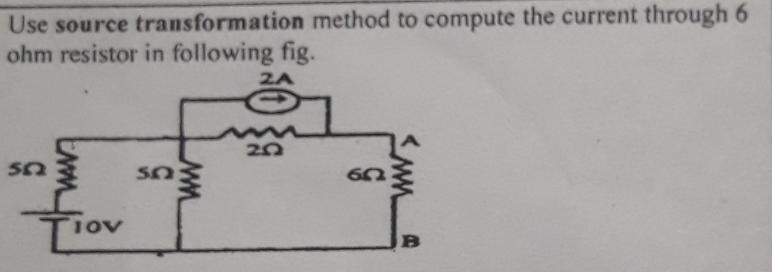Use source transformation method to compute the current through 6 ohm resistor in the following fig.

Understand the Problem
The question is asking to apply the source transformation method to find the current flowing through a 6-ohm resistor in the provided electrical circuit diagram.
Answer
The current through the $6 \Omega$ resistor is approximately $I_{6\Omega} \approx 1.615 A$.
Answer for screen readers
The current flowing through the $6 \Omega$ resistor is approximately $I_{6\Omega} \approx 1.615 A$.
Steps to Solve
- Identify the components of the circuit
Identify the voltage source, current sources, resistors, and their values from the circuit diagram. Here, we have:
- A voltage source of $10 V$.
- A current source of $2 A$.
- Resistors with values $5 \Omega$, $2 \Omega$, and $6 \Omega$.
- Transform the voltage source to a current source
Use the source transformation method. To transform the $10 V$ voltage source in series with a $5 \Omega$ resistor to a current source: $$ I = \frac{V}{R} = \frac{10 V}{5 \Omega} = 2 A $$ So, the voltage source can be represented as a $2 A$ current source in parallel with a $5 \Omega$ resistor.
- Redraw the circuit with the transformed source
Now, we redraw the circuit replacing the $10 V$ source with the equivalent $2 A$ current source and a $5 \Omega$ resistor in parallel with it. This will create a new circuit arrangement.
- Calculate the combined resistance in the circuit
Next, calculate total resistance seen by the $6 \Omega$ resistor. The $5 \Omega$ resistor is in parallel with the original $2 A$ current source.
The effective resistance $R_{eff}$ can be found using: $$ \frac{1}{R_{eff}} = \frac{1}{5 \Omega} + \frac{1}{2 \Omega} $$
- Solve for the combined resistance
Calculate the effective resistance: $$ \frac{1}{R_{eff}} = \frac{1}{5} + \frac{1}{2} = \frac{2 + 5}{10} = \frac{7}{10} $$
So, $$ R_{eff} = \frac{10}{7} \Omega \approx 1.43 \Omega $$
- Using current division to find the current through the $6 \Omega$ resistor
Using the current division rule: $$ I_{6\Omega} = I_{total} \cdot \frac{R_{parallel}}{R_{total}} $$
Where,
- $I_{total} = 2 A$ (the total current),
- $R_{parallel} = 6 \Omega$,
- $R_{total} = R_{eff} + 6 \Omega$.
Now, calculate total resistance: $$ R_{total} = \frac{10}{7} + 6 = \frac{10 + 42}{7} = \frac{52}{7} \Omega $$
Now substitute values: $$ I_{6\Omega} = 2 A \cdot \frac{6}{\frac{52}{7}} = 2 A \cdot \frac{6 \cdot 7}{52} = 2 A \cdot \frac{42}{52} = 2 A \cdot \frac{21}{26} $$
Finally calculate: $$ I_{6\Omega} \approx 1.615 A $$
The current flowing through the $6 \Omega$ resistor is approximately $I_{6\Omega} \approx 1.615 A$.
More Information
In source transformations, a voltage source in series with a resistor can be converted into a current source in parallel with the same resistor, and vice versa. This technique simplifies analyzing complex circuits.
Tips
- Incorrect transformations: Ensure that you correctly apply the source transformation formulas; failure to properly transform can lead to computation errors.
- Ignoring resistances: Ensure to account for all resistances present in parallel and series when calculating total resistance.
AI-generated content may contain errors. Please verify critical information